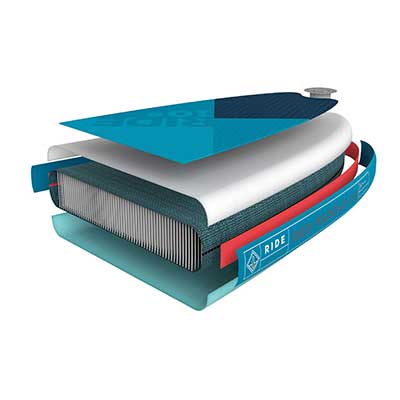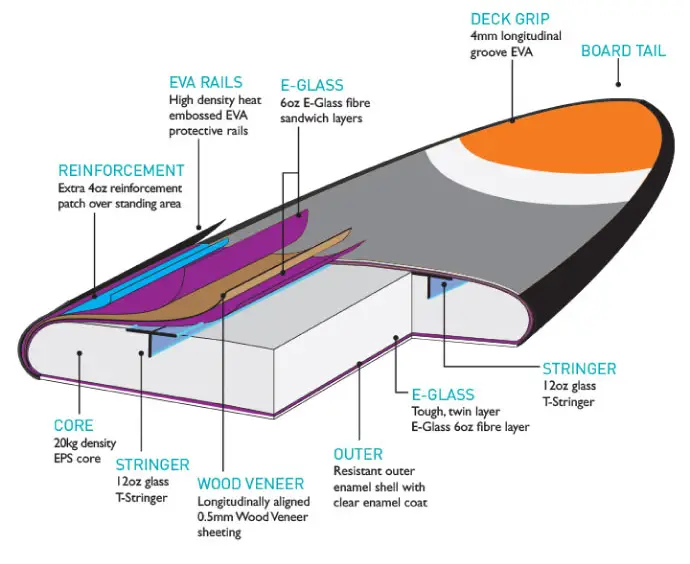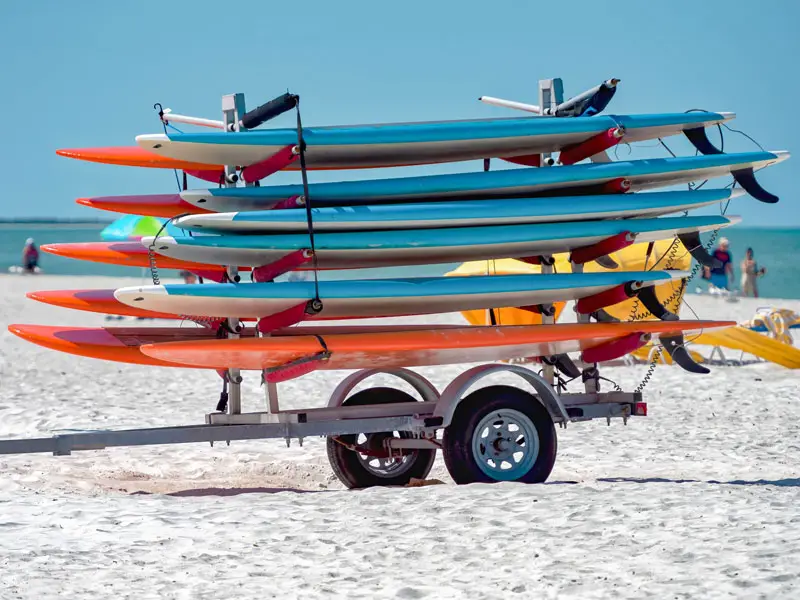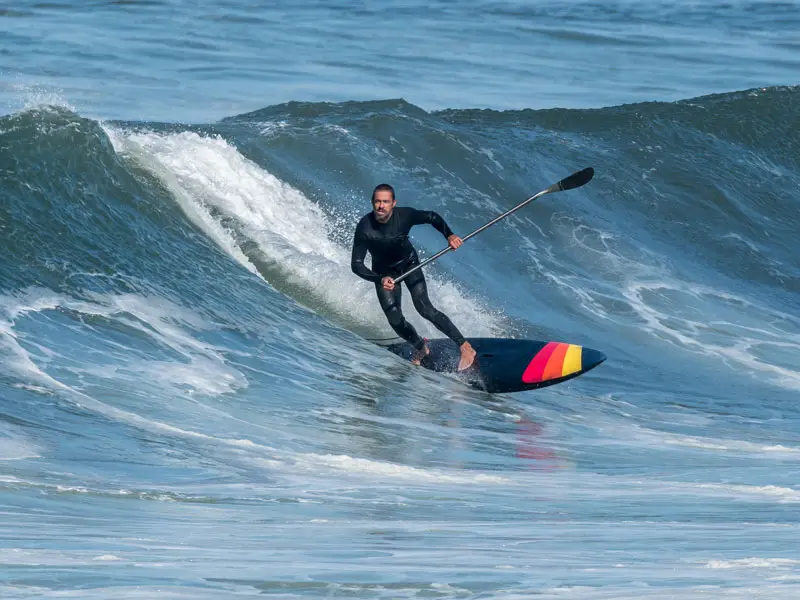Stand up paddle boarding has taken off in recent years, largely due to the popularity of inflatable paddle boards. But, the question remains, are inflatable boards any good, or are they just expensive pool floats? The debate of inflatable VS hard paddle boards has been going on since the first the first inflatable board was invented, but which is best?
The quick answer is that with recent advances in material and manufacturing technology, quality modern inflatable boards have the advantage over hard boards in terms of portability, durability, price, and weight. When used for all-around casual leisure paddling, the performance of an inflatable paddle board so closely mimics a hardboard, it can be difficult to notice a difference. However, if you are looking to use your board for more technical paddling, such as racing or SUP surfing, you will find hardboards have the edge.
What Are Inflatable Paddle Boards Made From?
Almost all inflatable paddle boards are made from polyvinyl chlorate fabric, or PVC for short. The quality, thickness, and number of layers of PVC determine how strong and durable the board will be, and is a good way to judge if an inflatable board is any good. Cheap paddle boards will use one thin layer of PVC, whereas good quality brands use two or more layers of military-grade PVC.
It isn’t just a PVC shell, manufacturers use a system called drop stitching that ties the top and bottom of the board together with thousands of threads. This is what allows them to hold their board shape and stops them from becoming a large balloon.
The Boards are finished off with a neoprene or rubber deck pad, reinforced rails (the side bits), a one-way valve for inflating and deflating the board, and fins attached.

Hard Board Construction
The most common construction of hard paddle boards is a core made from EPS foam (expanded polystyrene), fiberglass and epoxy layers, and coverd with a soft grippy deck pad. Some of the more expensive hard boards use carbon fiber or composite materials to reduce weight even further.
Cheaper hard boards are sometimes made from an injection molded thermoplastic shell with a hollow interior, these are commonly known as “pop-outs”.

Portability And Board Storage
Portability and storage are areas where inflatable paddle boards come head and shoulders above hard boards. When deflated and rolled away, inflatable boards fit into a carry bag with space for the pump, fins, leash, and paddle. Most carry bags come as a backpack, but many are also equipped with wheels to drag it around behind you. On the other hand, hard boards are bulky and difficult to carry. Carry straps are available for hard boards, but the length of the board is still cumbersome.
This portability advantage isn’t only when you are on foot. Inflatable paddle boards do not require a truck, roof racks, straps, or a trailer. You can easily fit packed away inflatable paddle boards in the trunk or on the back seat of even a small hatchback.
If you don’t have a lot of space at home, or live in an apartment, you will find an inflatable board much easier to store. Hard boards require special racks on the wall or ceiling, where as an inflatable paddle board can fit in your closet or under the bed.

Traveling With Your Paddle Board
The compact nature of inflatable paddle boards that makes them easy for taking down to the local lake also makes them great for traveling much longer distances. Check with your carrier first, but most carry bags are hold friendly so will only require you to purchase one extra bag when jetting off to a destination. Hard boards require special care when traveling to avoid damage and will cost extra as oversized sporting goods. For this reason, many people choose inflatable boards as their go-to when traveling.
Inflatable Paddle Boards Are More Durable
Now, I know that it sounds crazy. After all, hard boards are hard therefore must be tougher, right? No, Actually a well-made inflatable paddle board with multiple layers of PVC will bounce off rocks, logs, and other obstacles where a hard board may crack or dent. As a general rule of thumb, you don’t need to handle an inflatable board with quite as much care as a hard paddle board.
Do Inflatable Paddle Boards Puncture Easily?
As previously mentioned, a well made inflatable paddle board from a reputable manufacturer and not a cheap generic board should be resistant to most punctures when subject to everyday use. That’s not to say that they can’t get a puncture, it is certainly possible. However, the key is to look for a paddle board with more layers of military-grade PVC. The more layers of PVC, the less easily a paddle board will be to puncture.
Can Inflatable Paddle Boards Pop?
Yes, it is possible for inflatable paddle boards to pop. However, maybe not necessarily in the way that you would expect. They are highly resistant to external pressure, with Red Paddle Co even running one of their inflatable boards over with a 22 ton digger.
The most common cause of popped paddle boards is a combination of over-inflation and being left out in the hot sun. When the board heats up, the pressure inside increases significantly, and combined with the reduced effectiveness of the glue when hot, causes the seams to rupture. For this reason, you shouldn’t leave fully inflated paddle boards in direct sunlight – except when you are using them of course!
Can Inflatable Paddle Boards Sink?
While they are very tough and safe, if a single chamber inflatable paddle board was to loose pressure due to a large puncture or valve failure it would sink. This is a very unlikely scenario, but if it is a worry to you there are double chamber inflatable paddle boards available.
On the other hand, a hardboard will always remain buoyant due to its EPS foam (expanded polystyrene) core. This is an area where hard boards come out on top, but unless you plan to paddle long distances from shore or for long periods of time, I wouldn’t worry too much about it. Either board you choose, make sure you know the laws about life jacket use when paddle boarding.
Can Inflatable Paddle Boards Be repaired?
Yes, they can usually be repaired quicker and easier than hardboards, requiring sanding and re-fiberglassing. Inflatable paddle boards usually come with a patch kit, normally found in a distinct orange tube, that can be used to fix small punctures. Any larger damage or damage near the seams, I would advise you to take it to a professional repair shop.
Occasionally inflatable paddle boards can be subject to manufacturing defects that require a whole board replacement. Buying from a reputable brand with a long warranty is the best way to protect yourself from this.
Performance Of Inflatable Boards – How Does It Compare?
There is a slight difference in performance between inflatable paddle boards and hard boards, with hardboards coming out on top. This is down to the nature of the materials used, and limits in shaping an inflatable paddle board.
Materials
Even high end inflatable boards have a slight bit of flex when you are standing and paddling them. This means that a small percentage of your paddle stroke energy is transferred downwards to the water instead of propelling you forward.
There is also the factor of friction between the board and the water. While PVC may feel smooth, it is has more friction on the water than an epoxy hard board.
Shaping
Designers are more limited in the shaping of inflatable boards when compared to hard boards. The nature of being inflatable makes it more difficult to create narrow noses, sharp lines, and the desired rocker. However, advances in design software and material technology have significantly improved inflatable paddle boards in the past 10 years.
What Is The Difference In Speed Between A Hard Board And Inflatable?
While these factors mean an inflatable board has lower performance when compared to a hardboard, the difference is minimal. A test done by ISLE SUP and Surf found only a 5% difference in speed between comparable boards. For the everyday non-competitive paddleboarder, the difference is so small and trivial that it isn’t worth considering.
Are Inflatable Boards Any Good For Surfing?
While it is certainly possible to surf on an inflatable board, most serious SUP surfers tend to use hardboards. This is because hardboards are more ridged, therefore more responsive in the waves than inflatable boards, and can be made with more angular rails and corners.
There are specially designed inflatable SUP surf boards, but you can try surfing with any board; it just won’t have quite the same performance as a surf specific board.

Are Inflatable Boards Any Good For Racing?
Hardboards have an undeniable advantage compared to inflatable paddle boards. Some high end hardboards are made superlight using carbon fiber and other technically advanced materials. However, inflatable boards are closing the gap and have come a long way over the years, and may people do use them for racing.
The main reason is due to their portability. If you are on the racing circuit, you will likely be traveling a lot, sometimes overseas. Flying with a 14′ carbon race board is difficult and expensive, so inflatable race boards have their place.
The Price Difference
As a general rule of thumb, inflatable paddle boards are cheaper than comparable hardboards. There are a number of reasons for this, as fully explained in Why Are Paddle Boards So Expensive. The materials used to construct a hardboard are more expensive, it costs more to manufacture, ship, and store when compared to inflatable boards.
In fact, you can buy decent quality budget inflatable paddle boards for as little as $400 – $600. In our top pick of the best budget paddle boards, they are all inflatable boards.
What Are The Disadvantages Of Inflatable Paddle Boards?
By far the largest disadvantage of inflatable paddle boards is at the expense of their portability, they need to be inflated and deflated before and after use. Inflatable boards take a load of pressure to make them stiff enough to stand on. A normal recommended pressure is 15-18 PSI, although some boards can withstand as much as 28 PSI! To put that into perspective, car tires are in the range of 30 – 35 PSI.
It normally takes between 8 – 15 minutes of pumping to fully inflate your board manually, depending on how energetic you are feeling. However, if you don’t want to manually inflate your board, there are electric paddle board pumps available.
Deflating the board is much quicker, although you will want to ensure it is clean and fully dry before packing it away. This is still much slower than hard boards that you can just tie onto your roof rack and drive home.
Conclusion: Are Inflatable Boards Any Good?
A better question might be are inflatable boards any good for me? Inflatable paddle boards are great for flatwater, leisure, and travel paddling. However, if you want to surf or race competitively on your board, then hard boards will have a technical advantage.
Another important consideration with inflatable paddle boards is the quality of the board itself. Cheap low-quality boards can be a waste of money and should be avoided at all costs.
Check out the video below from Blue Planet Surf for their assessment of hard boards vs inflatable.
